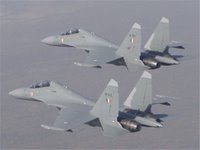 Ever since the US agreed to sell F-16 fighter aircraft to Pakistan, there has been a spate of reports in the media about the alleged proposal by the US to sell the more advanced Boeing F/A-18 E/F "Super Hornet" (left) fighter aircraft to India. However, the deal is not likely to materialise (and shouldn't be allowed to either), for several reasons. Firstly, the F/A-18 E/F and the Russian Su-30MKI share roughly the same mission profile that includes air superiority, close and deep air support, and day and night strike missions, to name a few. Deploying two similar aircraft to carry out similar missions would serve no useful purpose for obvious reasons and prove to be a logistical nightmare for the Air Force.
Ever since the US agreed to sell F-16 fighter aircraft to Pakistan, there has been a spate of reports in the media about the alleged proposal by the US to sell the more advanced Boeing F/A-18 E/F "Super Hornet" (left) fighter aircraft to India. However, the deal is not likely to materialise (and shouldn't be allowed to either), for several reasons. Firstly, the F/A-18 E/F and the Russian Su-30MKI share roughly the same mission profile that includes air superiority, close and deep air support, and day and night strike missions, to name a few. Deploying two similar aircraft to carry out similar missions would serve no useful purpose for obvious reasons and prove to be a logistical nightmare for the Air Force. Secondly, The Su-30MKI (left) is far superior to the F/A-18 E/F when it comes to combat capability, on account of its ability to carry far greater payload as compared to the F/A-18 E/F, a normal operating range of more than 3000 km (and a maximum of 5200 km), as opposed to about 390 km for the F/A-18 E/F, an extremely powerful radar, and thrust vectoring engines which give it class-leading manoeuvrability no western aircraft can match. All these features, combined with a superb mix of Russian, Israeli, and Indian avionics make the Su-30MKI one of the finest fighter aircraft in the world, if not the very best. In fact, the Su-30MKI is so advanced, that not even the Russians (let alone the Chinese) have anything in their inventory which can match it. It is closer in performance to the Su-37 and Su-35, rather than to Russian or Chinese Su-30s. Moreover, at $30 million apiece, the Indian manufactured version of the Su-30MKI comes relatively cheap, costing almost half as much as the F/A-18 E/F, which is priced at $57 million.
Secondly, The Su-30MKI (left) is far superior to the F/A-18 E/F when it comes to combat capability, on account of its ability to carry far greater payload as compared to the F/A-18 E/F, a normal operating range of more than 3000 km (and a maximum of 5200 km), as opposed to about 390 km for the F/A-18 E/F, an extremely powerful radar, and thrust vectoring engines which give it class-leading manoeuvrability no western aircraft can match. All these features, combined with a superb mix of Russian, Israeli, and Indian avionics make the Su-30MKI one of the finest fighter aircraft in the world, if not the very best. In fact, the Su-30MKI is so advanced, that not even the Russians (let alone the Chinese) have anything in their inventory which can match it. It is closer in performance to the Su-37 and Su-35, rather than to Russian or Chinese Su-30s. Moreover, at $30 million apiece, the Indian manufactured version of the Su-30MKI comes relatively cheap, costing almost half as much as the F/A-18 E/F, which is priced at $57 million.
Finally, the United States’ poor track record as a reliable arms supplier is probably the most important reason not to buy the F/A-18s. The sale of these aircraft as well as the unhindered supply of spares is dependent on the whims of US Congressmen and Senators. India should learn from the Pakistani experience in this regard. During the Afghan war, the Reagan administration decided to sell about 80 F-16 Fighting Falcons to Pakistan. However, due to Pakistan’s nuclear proliferation activities, the sale was suspended after 40 aircraft were delivered, even though all 80 had been paid for, under the Pressler amendment. Pakistan had to struggle to even claim this money back. While this move served Indian interests well, it was not exactly an advertisement of American reliability. Make no mistake; if they could do this to Pakistan, they can do it to India. However no such problems exist as far as Russian arms are concerned. Even the French have laid to rest all doubts as far as reliability issues go. Their support for India’s nuclear tests in 1998 (France and Russia were the only countries which supported us) was ample proof of this.

No comments:
Post a Comment